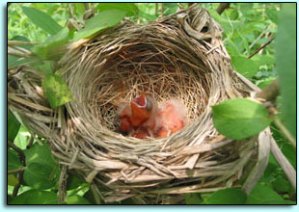On Tuesday morning as I dragged my sorry self out of bed something felt different. I couldn’t quite pin it down. It wasn’t until as I juggled briefcase, purse, coffee cup and keys did it click. The red-winged blackbirds (Agelaius phoeniceus) were BACK! I heard a cacophony of conk-la-ree! song from the meadow. Aside from the obvious prolonged daylight that results when the Northern hemisphere is once more beginning its lean towards the sun, the blackbird is one of my indicator animals for the onset of spring. I usually equate them with the week of the spring equinox. This year, however, they are back about 2 weeks earlier than normal. Now I should probably qualify my statement above, because some avid birdwatcher will call my bluff and say that the red-winged blackbird is a winter visitor in this part of MA. That is indeed true for some subset of the population and if I wanted to go looking for one I would be likely to find one in a feedlot or crop field. It is their March return to the marshes and other wet areas that I refer to when I say they are “back.”

It’s not that the blackbird is unusual. In fact it is downright common although the colorful picture that the males make with their red-and-yellow shoulder badges is still pleasing to the eye. By comparison the female is nondescript and her behavior mirrors her camouflage of color. The behavior of the male reminds me, on the other hand, of a college frat boy. One reason is because the male redwing is territorial and very aggressive in protecting its boundary. I have seen them attack and chase crows, hawks and even ospreys. They also are very vocal and have been known to dive-bomb people when they approach active nesting areas. I can personally attest to this by the way and strongly recommend avoiding kayak excursions into an active territorial area. Another is their common tendency for polygamy where one territorial male redwing will have many female mates. Now guys, don’t take offense here, I am not casting one-sided aspersions. It turns out in the end that many of the young end up being sired by an individual other than the territorial male.

Redwings build their nests in a variety of habitats though a marsh, swamp, or wet meadow appears to be preferred. The female will weave an intricate nest platform out of cattail, rush, sedge, buttonbush, willow or other vegetation. They prefer this water-loving vegetation for the placement of the nest as well.

Now, I have seen other signs that I equate with spring such as full thaw, fog, and burgeoning leaf buds. Then there is the sweet sound of the black-capped chickadee’s spring song of fee-bie or sweet-ie. I have also observed the gray squirrels (Sciurus carolinensis) cutting and dropping the early buds and/or twigs from the silver maples (Acer saccharinum) in my neighborhood which means that the sap is running. The squirrel like us has a sweet tooth and when the sap begins to flow they clip the branches and buds to lick the sap from the cuts that they have made. So don’t forget to get out and enjoy the spring air, but watch out for falling branches.


bird nest is intriguing… work or art, never taught, always in bird’s mind!!
I agree Kakdah nature in itself is a work of art!
I never get to see these lovely creatures up close. Thanks for giving me a good view of their beauty. The nest of little ones is wonderful. Welcome to Blotanical!
Thanks! I really enjoyed roaming through your archives and your bud photos are incredible. I look forward to more posts.
I just found your Blog. Like it! The redwing Blackbirds are back here too this week. They really do make the “noise” early in the morning. A real sign of Spring. I have lots nesting here every year along the lake shore. So many birds migrate along the shore of Lake MIchigan on their way to and from Canada in Spring and Fall. It is a beautiful place for the contemplation of nature. I post lots of photos on my blog with the lake and the shore as a backdrop to the gardens. You might like going back over some past postings in the archives. Like you I have a deep commitment to the environment. I belong to a number of environmental groups that publish blogs on important issues in this area. I feel I am only a steward of this land while I walk it, then hope to pass it on in better shape when I leave. I look forward to visiting your blog now that I am going to be following it. Jack
I am the Jack from above. The Blog for my gardens is: http://www.gardensatwaterseast.blogspot.com Sometimes the wrong web site shows up so this is the one for you if you want to see the gardens and lake. Jack
Hi Jack, your landscape is amazing – what a view! Your photographs are incredible. I particularly like the winter scenery (I must be missing the winter snowfall we usually get) and the rain garden photos.
I really enjoy that you have a job in the wetlands. I am an architect and worked with a landscape architect designing for a reclamation site of a brown field on wetland property. I never talk about my professional work but am always interested when others do. I will make sure and see your posts. You have a great photo of the male blackbird in display. I can not even get a good photo of them at the feeders. I literally am begging them to show their wings.
Hi Donna, I really do enjoy my work in wetlands but actually am starting to move in the landscape design direction as a second career. There is so much to learn and explore. I particularly liked your winter tree photos and the otter post was so cute.
Cori,
I’ve never seen Red-winged Blackbird before. He’s wonderful!
Nadezda
Thanks for visiting my blog!
Always exciting to see red winged blackbirds, though I wouldn’t recognize the female;-)
Cheers!
Alice
aka Bay Area Tendrils
Hi Alice, they are pretty neat but unfortunately they are so common most people don’t even “see” them.
-Cori
Hi there! I just found your blog from Blotanical. I love it! I want to learn more about birds this year. I garden a ton but don’t know much at all about birds except for I like them! Your photo of the male with the wings spread is amazing and I also enjoyed the photo of the intricate nest. Like how you associate their habits with humans! 🙂
Hi, Andrea I am glad you like the blog. The birds are relatively new to me too and it seems like no matter how much I learn, I always find something else to bring my attention of the natural world to a new level. I am also starting to experiment with various organic gardening techniques such as permaculture and was enjoying going through your old posts. Congratulations on your first year and I will look forward to more. Still trying to get into a writing routine myself. Not always easy when everything is moving full speed ahead.
-Cori